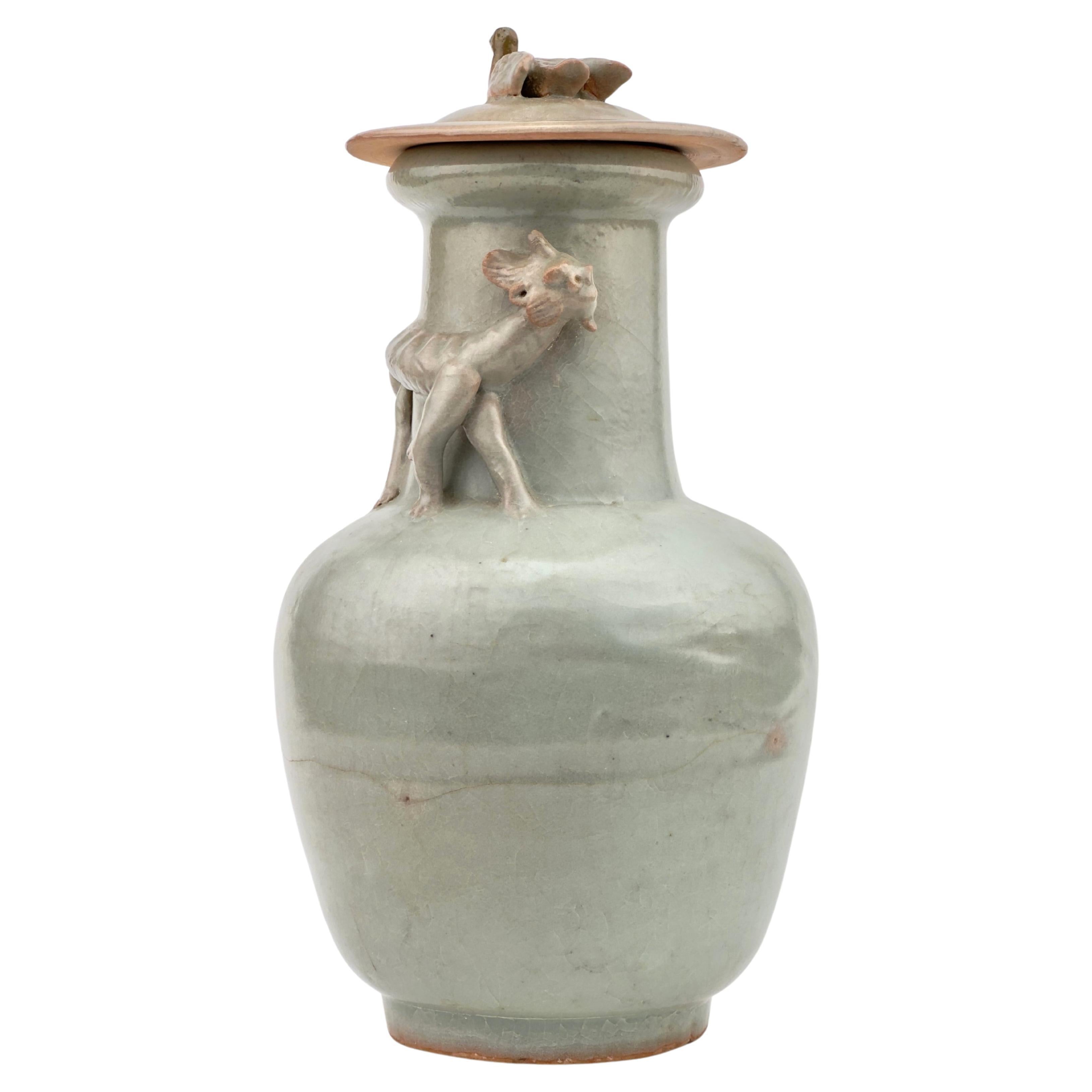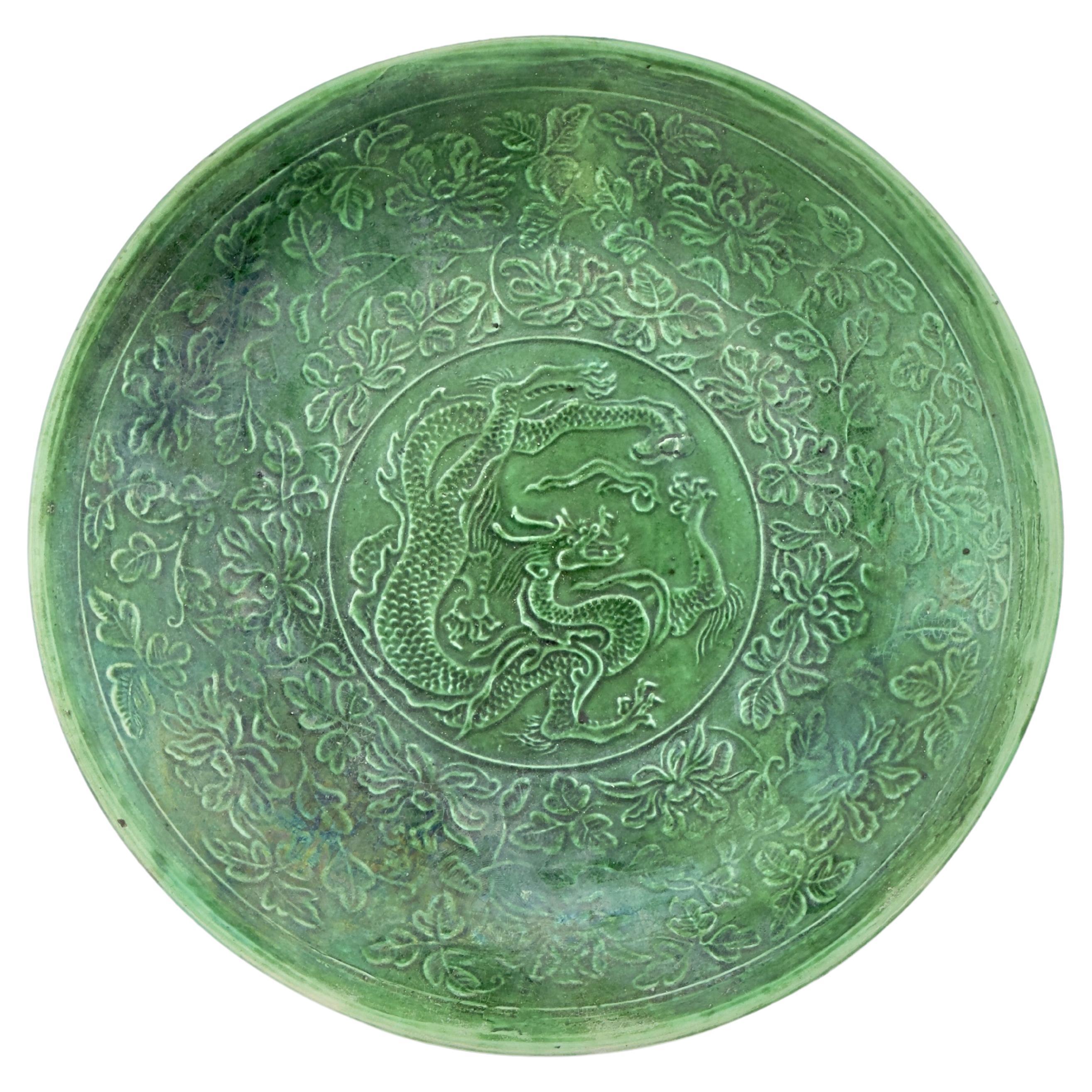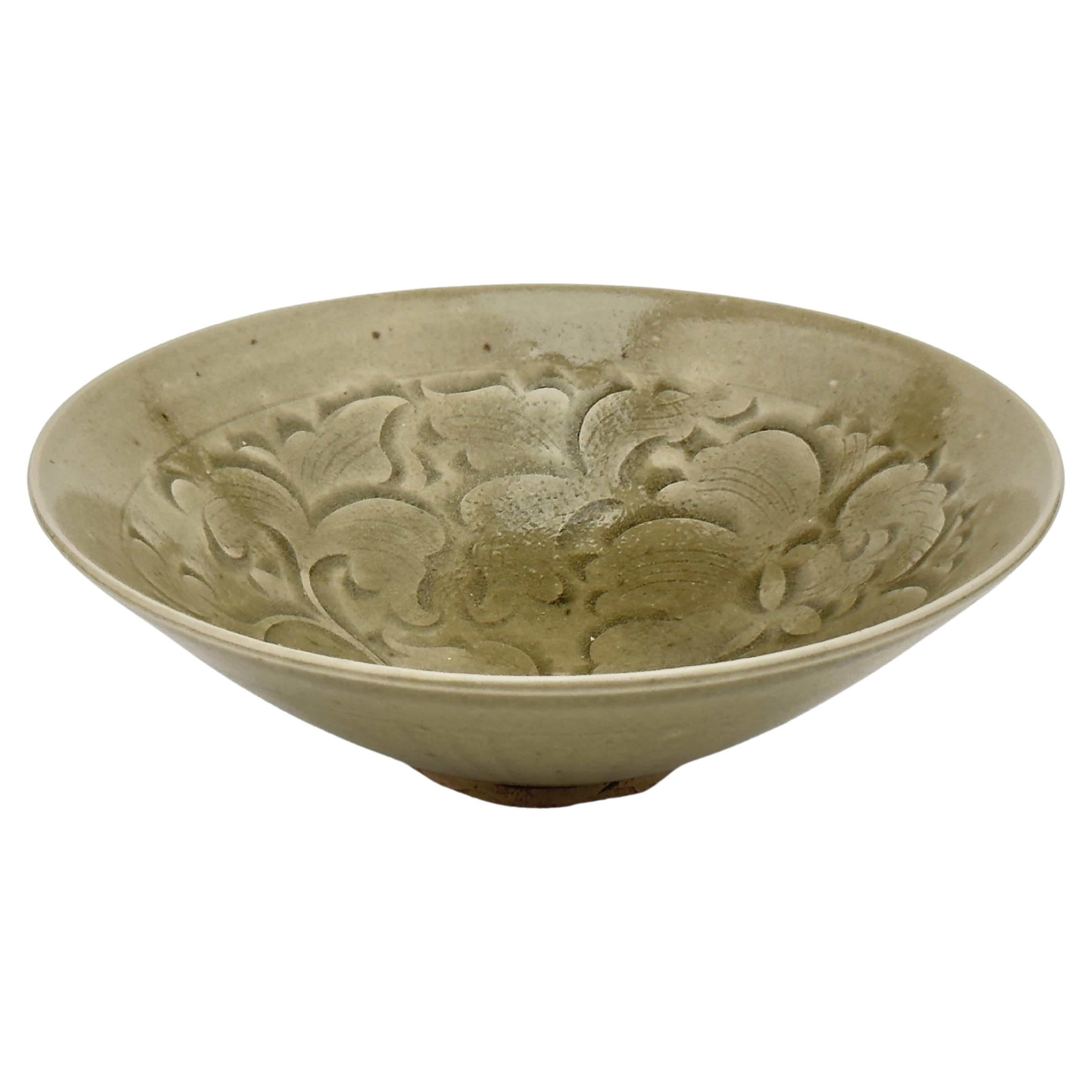Items Similar to Small Celadon Chrysanthemum Dish, Northern Song Dynasty(AD 960~1127)
Want more images or videos?
Request additional images or videos from the seller
1 of 13
Small Celadon Chrysanthemum Dish, Northern Song Dynasty(AD 960~1127)
About the Item
Potted with the fluted sides rising from a recessed base, carved to the interior with Chrysanthemum, covered overall with a grayish-green glaze, save for a ring to the underside left unglazed to reveal the gray stoneware body
Period : Jin Dynasty-Northern Song Dynasty
Type : Celadon
Medium : Yaozhou
Size : 13.0 cm(Diameter), 2.5cm(Height)
Provenance : Acquired in 1999, Hongkong
Reference :
1) Sotheby's New York 18 March 2017 - Saturday At Sotheby’s: Asian Art - Lot 1363
2) Christies Hongkong 3 DEC 2021 - Important Chinese Ceramics and Works of Art - Lot2967
* Yaozhou Celadon
The Yaozhou kilns, active during the Northern Song Dynasty (960–1127 AD), were located in modern-day Shaanxi Province and are renowned for their celadon wares. Yaozhou ceramics are distinguished by their olive or brownish-green glaze and the elegant, often spontaneous carving techniques employed in their decoration.
Yaozhou ware typically features carved or incised designs, sometimes with motifs that are impressively detailed. Common themes include floral patterns, such as peonies or chrysanthemums, and more abstract or geometric patterns. The carving is usually done in a 'sgraffito' technique, where the design is carved into the clay and then filled with the glaze, which after firing, reveals the pattern in a contrasting color against the darker body.
The forms of Yaozhou ceramics are often practical – including bowls, dishes, and jars – reflecting their use in daily life as well as for special occasions. The quality of the glaze, which ranges from a matte finish to a more glossy appearance, and the depth of the carving are particular characteristics that help identify Yaozhou wares. The aesthetic appeal of these ceramics lies in the harmony between form, decoration, and glaze, demonstrating the potters' skilled control over their craft.
During the Northern Song period, Yaozhou wares were highly valued and widely used, and they continued to influence Chinese ceramics in subsequent dynasties. Today, they are considered important artifacts and are highly prized by collectors and historians for their beauty and historical value.
About the Seller
New to 1stDibs
Joined in the past six months.
4.5
Vetted Seller
These experienced sellers undergo a comprehensive evaluation by our team of in-house experts.
Established in 1999
1stDibs seller since 2023
Typical response time: 1 hour
- ShippingRetrieving quote...Ships From: seoul, Korea South
- Return PolicyA return for this item may be initiated within 10 days of delivery.
More From This SellerView All
- Longquan Celadon Five-Spouted Jar, Northern Song Dynasty (AD 960~1127)Located in seoul, KRThickly potted with an ovoid body of five horizontal lobes tapering toward the top, carries both aesthetic and practical values. The jar is intricately carved with rows of upright lo...Category
Antique 15th Century and Earlier Chinese Ming Antiquities
MaterialsCeladon
- A Rare Cream-Glazed Ewer and Cover, Northern Song Dynasty (960–1127)Located in seoul, KRThe octagonal lobed ovoid body rising from a short spreading foot to a tall trumpet neck, set at the shoulder with a tall curved spout and to the other side with a tall strap handle, the dished cover surmounted with a ruyi-shaped finial, covered overall in a creamy-white glaze. Compared to other similar types of Northern Song Dynasty ceramics, this piece is extremely elegant in shape. It most closely resembles the Qingbai porcelain in the collection of The Museum of Oriental Ceramics in Osaka. Period : Northern Song dynasty(960~1127) Type : Creamy-white glaze Ewer Provenance : Acquired in 1999, Hongkong Reference : THE MET Accession Number: 18.57.1 Sotheby's London 2018 - St George Street Sale Asian Art - Lot 208 * Song Dynasty Ding-Yao Ware Song Dynasty Ding Yao porcelain holds a significant place in Chinese ceramic art, specifically as a type of white porcelain produced during the Song Dynasty. Produced predominantly during the mid to late Song Dynasty, Ding Yao ceramics are renowned for their delicate and intricate features. Ding Yao ceramics were primarily crafted from clay rich in white minerals and fired at high temperatures to achieve a durable and lustrous surface. One distinctive characteristic of this serene white ceramic is the presence of silver or gold-colored splashes of glaze, often created using a mineral called galena. Galena, with its lustrous appearance, was suitable for creating fine patterns and intricate decorations. These ceramics frequently feature delicate carvings, floral motifs, or subtle decorations. While commonly used for utilitarian purposes such as tableware, Ding Yao porcelain also served as a medium for artistic expression, producing many artworks. The production of Ding Yao ceramics was relatively limited, and surviving pieces are considered rare and valuable art pieces...Category
Antique 15th Century and Earlier Chinese Ming Antiquities
MaterialsCeramic
- Longquan Celadon 'Dragon' Jar and Cover, Southern Song Dynasty(1127–1279)Located in seoul, KRA similar jar with a cover, part of the Avery Brundage collection at the Asian Art Museum in San Francisco, is featured in Mary Tregear's "Song Ceramics" (London, 1982, plate 286). T...Category
Antique 15th Century and Earlier Chinese Ming Antiquities
MaterialsCeladon
- A Rare Dingyao Green-Glazed Dragon Dish, Northern Song DynastyLocated in seoul, KRThis green-glazed bowl was finely crafted with an attention to detail that highlights the skill of the Cizhou green and Ding ware potter. Its delicate form has been adorned with a dr...Category
Antique 15th Century and Earlier Chinese Ming Antiquities
MaterialsCeramic, Stoneware
- Celadon Vase, Five Dynasties or Northern Song dynasty, 10th-11th CenturyLocated in seoul, KRThe form of Longquan celadon vases from the Northern Song dynasty evolved from an early design with a long neck and tapering body to a later ovoid body with a shorter neck. Over time, the glaze developed a more olive tone, and the carved decorations became more pronounced and intricate. Examples of such vases include one without a cover dated to the Yuanfeng era (1078~1085) and documented in literature, and another similar vase without loop handles preserved by the Qingyuan County Cultural Relics Bureau. An earlier example featuring loop handles and a lotus-like cover is also mentioned in historical texts. The use of Longquan covered vases, especially as funerary jars for offerings like wine and grains, was highlighted by an inscription on a piece from the Sir Percival David Collection, London. This inscription wishes for the vessel to preserve fragrant wine for centuries, blessing the owner with prosperity, longevity, and a vast lineage, dated to the third year of the Yuanfeng period (1080). This practice was common in the regions of Southern Zhejiang and Northern Fujian. A similar celadon vase from the Linyushanren collection was auctioned at Christie’s Hong Kong, emphasizing the cultural and historical significance of these artifacts. Period : Five Dynasties or Northern Song Dynasty Type : Celadon, Zhejiang province Medium : Celadon Size : 31.5 cm(Height) x 11.5(Diameter) Provenance : Acquired in late 1990s from Hongkong Reference : 1) The British Museum image id - 01613270570 2) Christies New York 23–24 MAR 2023 - Important Chinese Ceramics and Works of Art - Lot 1012 (Price Range : USD 18,000 – USD 25,000 / Type : Related) 3) National Gallery of Victoria - Accession Number - AS5-1973 * Celadon from Five Dynasties (907~960) to the early Northern Song Dynasty (960~1127) The period from the Five Dynasties (907~960) to the early Northern Song Dynasty (960~1127) marked a significant transitional phase in the development of Chinese celadon ceramics...Category
Antique 15th Century and Earlier Chinese Ming Antiquities
MaterialsCeladon
- Carved 'Yaozhou' Celadon-Glazed Bowl, Song DynastyLocated in seoul, KRThe bowl is potted with steep, flared sides and decorated to the interior with stylized peonies among scrolling tendrils. The exterior is carved with vertical lines below the everted...Category
Antique 15th Century and Earlier Chinese Ming Antiquities
MaterialsCeladon
You May Also Like
- China 960 Ad Song Dynasty Very Rare Imperial Period Offering Vessel in BronzeLocated in Miami, FLOffering vessel from the Chinese Song Dynasty (960/1279 AD ). A beautiful "offering spiritual vessel" from the Yunnan province region in the ancient China. This rare vessel was created in red bronze during the Song Dynasty period. between 960/1279 AD. This is one of the most unusual forms of red bronze jar. A large vessel, the sides are virtually perpendicular to the base. The stepped lid design is also among the more rare types. The predominant lid design among the Yunnan offering bronzes is the "wheel" pattern, with a few lids having the lotus design. This is also one of the few bronzes displaying clear riveting of a two-part vessel body, with the original twisted elements Has a combined measures including the lid of 12.5 by 8.75 inches (31.75 x 22,23 Cm). The Song Dynasty, was an imperial dynasty of China that began in 960 and lasted until 1279. The dynasty was founded by Emperor Tizu of Song following his usurpation of the throne of the later Zhou, ending the Five-Dynasties and Ten Kingdoms period. The Song often came into conflict with the contemporaneous Liao, Western Xia and Jin dynasties in northern China. After decades of armed resistance defending southern China, it was eventually conquered by the Mongol-led Yuan dynasty. The dynasty is divided into two periods: Northern Song and Southern Song...Category
Antique 15th Century and Earlier Chinese Medieval Antiquities
MaterialsBronze
- Chinese Pottery Camel, Northern Wei Dynasty (386 - 535 AD), China, TL TestedLocated in Austin, TXA delightful and rare Chinese painted high fired gray pottery model of a wooly camel, Northern Wei Dynasty (386 - 535 AD), China, with TL test. The charming camel is portrayed stand...Category
Antique 15th Century and Earlier Chinese Antiquities
MaterialsPottery
- China 549-577 AD Northern Qi Dynasty Ancient Caparisoned Horse in EarthenwareLocated in Miami, FLExtremely rare Chinese pottery caparisoned horse from the Northern Qi region. A beautiful large sculptural piece, created in China during the Northern Qi dynasty period, between the 549 and 577 AD. This horse statue is extremely finely modeled of earthenware pottery, standing in a very elegant and majestic position striding on a trapezoidal shaped base. The animal has a gracefully arched neck to the left looking forward and its extremely well modeled. The head is adorned with a large detailed tassels of plumes and the body is embellished with a beautiful saddle and intricate harnesses. The trapping around the chest and rump is adorned with elaborated tassels and the straps are accented with multiples florets and bosses in high relief. Decorated with dotted and circles patterns. The surface is treated with applications of natural color pigments such; red, white and others. Has a measurements of 435 mm by 319 mm by 243 mm (17.10 x 12.55 x 9.55 Inches) (43.5 x 31.9 x 24.3 Cm). Northern Qi, was the successor state of the Chinese Xianbei state of Eastern Wei...Category
Antique 15th Century and Earlier Chinese Archaistic Antiquities
MaterialsEarthenware, Clay, Paint
- China 549-577 AD Northern Qi Dynasty Ancient Caparisoned Horse In EarthenwareLocated in Miami, FLExceedingly rare Chinese pottery caparisoned horse from the Northern Qi region. A beautiful sculptural piece, created in China during the Northern Qi dynasty period, between the 549 and 577 AD. This horse statue is extremely finely modeled of earthenware pottery, standing in a very elegant and majestic position striding on a trapezoidal shaped base. The animal has a gracefully arched neck to the left and its extremely well modeled. The head is adorned with a large detailed tassels of plumes and the body is embellished with a beautiful saddle and intricate harnesses. The trapping around the chest and rump is adorned with elaborated tassels and the straps are accented with multiples florets and bosses in high relief. The surface is treated with applications of natural pigments such; red, white and others. Has a measurements of 394 mm by 343 mm by 257 mm (15.53 x 13.52 x 10.15 Inches) (39.4 x 34.3 x 25.7 Cm). Northern Qi, was the successor state of the Chinese Xianbei state of Eastern Wei...Category
Antique 15th Century and Earlier Chinese Archaistic Sculptures and Carvings
MaterialsEarthenware, Pottery
- Chinese Song Period Celadon Glazed BowlLocated in London, GBA Chinese Song period celadon glazed bowl. Really nicely thinly potted example with craquelure due to age. Provenance: From a private London coll...Category
Antique 15th Century and Earlier Chinese Archaistic Antiquities
MaterialsPottery
- Small Chinese Tang/Song Dynasty Pottery Kowtowing Official, Ex. Christie'sLocated in Austin, TXA rare and elegant Chinese small unglazed pottery figure of a kowtowing official, Tang to Song Dynasty, 10th century, China, ex. Christie's, NY. The small figure of hand modeled e...Category
Antique 15th Century and Earlier Asian Tang Antiquities
MaterialsEarthenware, Pottery
Recently Viewed
View AllMore Ways To Browse
Yue Celadon
Large Wall Pieces
Chests For The Living Room
Vintage 90
Midcentury Modern Ceramic Table Lamp
Entry Surround
Glass Floor Lamp Italian Glass
1950s Side Table Table
Antique Pendant Antique Pendant Light
Up Up Coffee Table
New England Style Furniture
Couches Mid Century Designer
Liberty A
Table Top Cases
Branching Lighting
Similar Items
Finnish Design Chair
Entry Way Piece





